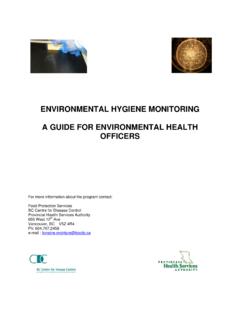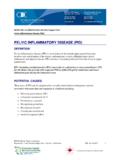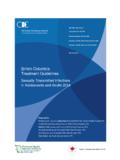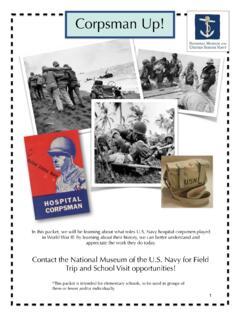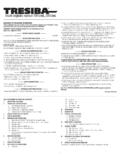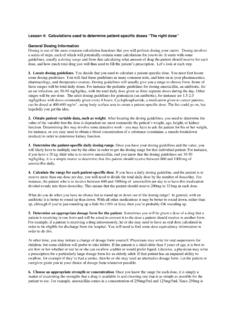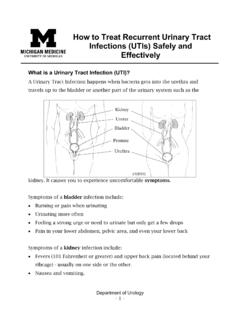Transcription of A Quick Guide To Common Childhood Diseases
1 A Quick Guide To Common Childhood Diseases May 2009 Table of Contents Introduction ..1 How are illnesses and infestations spread? .. 2 Routine 4 Handwashing .. 5 Other 8 Campylobacteriosis .. 9 Chickenpox (Varicella).. 10 Cold Sores .. 11 12 Cryptosporidiosis ( Crypto ) .. 13 E. Coli (Escherichia Coli): Diarrhea Illness and Hemolytic Uremic Syndrome .. 14 Fifth Disease (Erythema Infectiosum) .. 15 Giardiasis ( Beaver Fever ) .. 16 Haemophilus Influenzae type B (Hib).
2 17 Hand, Foot, and Mouth Disease ..18 Head Lice (Pediculosis) .. 19 Hepatitis A .. 20 Impetigo ..21 Measles ..23 Meningitis .. 24 Meningococcal 25 Methicillin-Resistant Staphylococcus Aureus (MRSA).. 26 Molluscum 27 Mononucleosis ( Mono ).. 28 Norovirus ( Norwalk virus ) .. 30 Pertussis (Whooping Cough) .. 31 Pink Eye (Conjunctivitis) .. 32 Pinworms .. 33 Respiratory Syncytial Virus ( RSV ).. 34 35 Roseola Infantum ( Sixth Disease ).. 36 Rubella (German Measles) .. 38 Salmonellosis .. 39 Shigellosis.
3 41 Shingles ..42 Streptococcal Infections: Scarlet Fever and Strep Throat .. 43 Swimmer s Itch .. 44 References .. 45 1 Introduction The purpose of the Quick Guide to Common Childhood Diseases is to provide general information about communicable Diseases commonly experienced by young children. It is a Quick reference only and is intended to assist care providers with identifying Common Childhood Diseases so that actions can be taken to decrease the spread of the illness or infestation to others.
4 Parents and caregivers who would like more information regarding the illnesses and infestations described in this Guide or information on how to care for their sick child can refer to Other Resources. The Guide is for people who care for young children. This includes people who work in childcare and daycare facilities, early learning centres, preschool, school, summer camp, and anywhere else that groups of young children spend time together. When children work and play together in groups, there is an opportunity for the spread of a number of Common Childhood Diseases that can be passed on from one child to the next.
5 Early recognition of the illness or infestation and prompt treatment can significantly reduce the spread within the group setting. The Diseases and infestations described in the Guide do not only affect children. Adults can develop symptoms and/or unknowingly spread the illness from one child to another. Each infectious disease in this Guide is described according to: What is it? Basic facts about the infectious disease A list of some of the signs and symptoms (not every child will have every symptom of the illness) How is it spread?
6 Description of how the illness or infestation is passed from child to child Incubation Period Length of time from when the child is first exposed to the illness to when the first symptoms appear in that child When is the person contagious? Description of the time period when an infected child is able to spread the illness or infestation to others How to prevent spread of the illness / infestation to other children Information regarding whether or not the child needs to be excluded from the school or child care facility Strategies to decrease the spread of the illness within the group setting.
7 2 How are illnesses and infestations spread? Most of the infections in this Guide are transmitted through direct and indirect contact with the nose and throat secretions of an infected person. This can happen when: An infected person coughs or sneezes without a tissue to cover their nose and mouth. Tiny droplets containing the virus or bacteria travel through the air and can infect a person who is close (less than a meter away). An infected person may have the virus or bacteria on their hands after wiping their eyes or nose, coughing, or sneezing.
8 If they touch another person s hand or an object, the virus or bacteria may be left behind. The virus or bacteria can infect the next person when that person touches their eyes, nose, or mouth. Some viruses and bacteria can remain on surfaces like doorknobs, faucets, telephones, and toys for many hours. People working with groups of children assist children with using or disposing of tissues. When the tissue is contaminated with the nose and throat secretions of an infected child, the virus or bacteria is readily transmitted to the hands of the staff member when they touch the tissue.
9 Several of the infections affect the gastrointestinal system (stomach and bowel). The bacteria or virus is often found in contaminated food or water but can be transmitted person to person, especially in a child care facility where children are in diapers. These viruses and bacteria are primarily transmitted when: Contaminated food is not cooked or cleaned properly. Contaminated water is not treated properly. There is direct contact with the stool (feces) of an infected person. This might happen when a caregiver changes a child s diaper or assists a child with toileting.
10 Even a tiny amount of stool on a caregiver s hand may contain virus or bacteria and infect them if they directly touch their mouth or prepare food before handwashing. There is indirect contact with infected stool. This might happen when a person with the virus or bacteria on their hands touches an object ( , faucet, light switch, door knob, or toy). The virus or bacteria can live on the object for long periods of time and be transmitted to anyone who touches the object. 3 Head lice is an infestation, not an infection.

